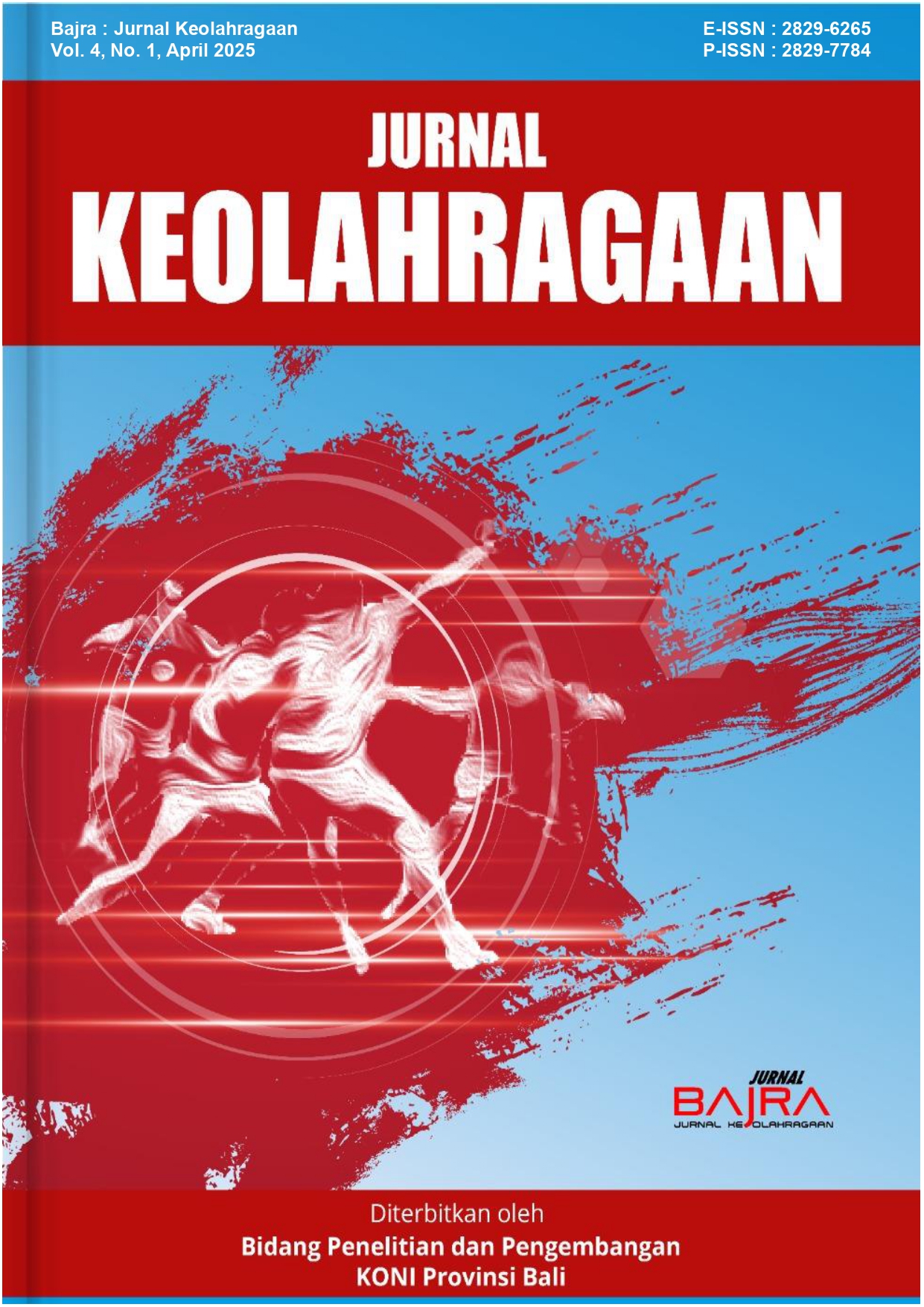HUBUNGAN TINGKAT KEBUGARAN KARDIORESPIRASI (VO₂MAX), KUALITAS TIDUR DAN KOMPOSISI TUBUH PADA POPULASI DEWASA MUDA : ANALISIS PERBEDAAN GENDER
DOI:
https://doi.org/10.5281/zenodo.15304324Keywords:
VO₂Max, kualitas tidur, komposisi tubuh, kesehatan masyarakatAbstract
Latar Belakang : Kebugaran kardiorespirasi (VO₂Max), kualitas tidur, dan komposisi tubuh merupakan indikator kunci kesehatan dewasa muda. Namun, interaksi ketiganya, terutama dalam konteks perbedaan gender, masih kurang terjelaskan, padahal disparitas biologis dan sosio-kultural berpotensi memengaruhi hasil intervensi kesehatan. Tujuan: Menganalisis hubungan VO₂Max, kualitas tidur, dan komposisi tubuh serta mengidentifikasi perbedaan signifikan antar gender pada populasi dewasa muda urban. Metode: Penelitian cross-sectional dengan 128 partisipan (96 laki-laki, 32 perempuan) berusia 18-25 tahun. VO₂Max diukur melalui Bleep Test, kualitas tidur dengan Pittsburgh Sleep Quality Index (PSQI), dan komposisi tubuh menggunakan Tanita MC-980U. Analisis statistik meliputi uji korelasi Spearman, uji-t independen, dan regresi linear multivariat. Hasil : Laki-laki memiliki VO₂Max lebih tinggi (32,5 vs. 25,1 mL/kg/min) dan massa otot lebih besar (46,2% vs. 34,7%), sementara perempuan memiliki lemak tubuh lebih tinggi (17,8% vs. 8,1%) serta kualitas tidur lebih buruk (68% skor PSQI >5). Korelasi positif kuat teridentifikasi antara VO₂Max dan massa otot (r = 0,72), serta korelasi negatif dengan lemak tubuh (r = -0,65) dan skor PSQI (r = -0,58). Massa otot menjadi prediktor terkuat VO₂Max (β = 0,62). Kesimpulan: Temuan mengonfirmasi pentingnya pendekatan berbasis gender dalam intervensi kesehatan, seperti program latihan resistensi-aerobik untuk perempuan dan manajemen stres untuk laki-laki. Keterbatasan desain cross-sectional dan ketidakseimbangan sampel menjadi catatan untuk studi lanjutan. Penelitian ini merekomendasikan integrasi skrining kebugaran dalam kebijakan kesehatan primer serta eksplorasi longitudinal dengan alat ukur objektif.
Downloads
References
Carneiro-Barrera, A., Amaro-Gahete, F. J., Acosta, F. M., & Ruiz, J. R. (2020). Body Composition Impact on Sleep in Young Adults: The Mediating Role of Sedentariness, Physical Activity, and Diet. Journal of Clinical Medicine, 9(5), 1560. https://doi.org/10.3390/jcm9051560
Consitt, L. A., Copeland, J. L., & Tremblay, M. S. (2001). Hormone Responses to Resistance vs. Endurance Exercise in Premenopausal Females. Canadian Journal of Applied Physiology, 26(6), 574–587. https://doi.org/10.1139/h01-032
Cornell, D. J., Paxson, J. L., Caplinger, R. A., Seligman, J. R., Davis, N. A., & Ebersole, K. T. (2017). Resting Heart Rate Variability Among Professional Baseball Starting Pitchers. Journal of Strength and Conditioning Research, 31(3), 575–581. https://doi.org/10.1519/JSC.0000000000001538
Jackson, A. S., & Pollock, M. L. (1978). Generalized equations for predicting body density of men. British Journal of Nutrition, 40(3), 497–504. https://doi.org/10.1079/BJN19780152
John W. Cresswel. (2009). Research Design: Qualitative, Quantitative, and Mixed Methods Approaches (3rd ed.). SAGE Publications.
Joyner, M. J., & Coyle, E. F. (2008). Endurance exercise performance: the physiology of champions. The Journal of Physiology, 586(1), 35–44. https://doi.org/10.1113/jphysiol.2007.143834
Karlsson, B. H., Knutsson, A. K., Lindahl, B. O., & Alfredsson, L. S. (2003). Metabolic disturbances in male workers with rotating three-shift work. Results of the WOLF study. International Archives of Occupational and Environmental Health, 76(6), 424–430. https://doi.org/10.1007/s00420-003-0440-y
Lund, H. G., Reider, B. D., Whiting, A. B., & Prichard, J. R. (2010). Sleep Patterns and Predictors of Disturbed Sleep in a Large Population of College Students. Journal of Adolescent Health, 46(2), 124–132. https://doi.org/10.1016/j.jadohealth.2009.06.016
Mallampalli, M. P., & Carter, C. L. (2014). Exploring Sex and Gender Differences in Sleep Health: A Society for Women’s Health Research Report. Journal of Women’s Health, 23(7), 553–562. https://doi.org/10.1089/jwh.2014.4816
Mandsager, K., Harb, S., Cremer, P., Phelan, D., Nissen, S. E., & Jaber, W. (2018). Association of Cardiorespiratory Fitness With Long-term Mortality Among Adults Undergoing Exercise Treadmill Testing. JAMA Network Open, 1(6), e183605. https://doi.org/10.1001/jamanetworkopen.2018.3605
Mondal, H. (2017). Effect of BMI, Body Fat Percentage and Fat Free Mass on Maximal Oxygen Consumption in Healthy Young Adults. JOURNAL OF CLINICAL AND DIAGNOSTIC RESEARCH. https://doi.org/10.7860/JCDR/2017/25465.10039
Power, M. L., & Schulkin, J. (2008). Sex differences in fat storage, fat metabolism, and the health risks from obesity: possible evolutionary origins. British Journal of Nutrition, 99(5), 931–940. https://doi.org/10.1017/S0007114507853347
Schmitz, B., Niehues, H., Thorwesten, L., Klose, A., Krüger, M., & Brand, S.-M. (2020). Sex Differences in High-Intensity Interval Training–Are HIIT Protocols Interchangeable Between Females and Males? Frontiers in Physiology, 11. https://doi.org/10.3389/fphys.2020.00038
Traustadóttir, T., Harman, S. M., Tsitouras, P., Pencina, K. M., Li, Z., Travison, T. G., Eder, R., Miciek, R., McKinnon, J., Woodbury, E., Basaria, S., Bhasin, S., & Storer, T. W. (2018). Long-Term Testosterone Supplementation in Older Men Attenuates Age-Related Decline in Aerobic Capacity. The Journal of Clinical Endocrinology & Metabolism, 103(8), 2861–2869. https://doi.org/10.1210/jc.2017-01902
Zhang, B., & Wing, Y.-K. (2006). Sex Differences in Insomnia: A Meta-Analysis. Sleep, 29(1), 85-93. https://doi.org/10.1093/sleep/29.1.85
Downloads
Published
How to Cite
Issue
Section
License
Copyright (c) 2025 Azry Ayu Nabillah, Africo Ramadhani, Erny Amalia Lestari, Muhamad Ihsan Hufadz

This work is licensed under a Creative Commons Attribution-NonCommercial-ShareAlike 4.0 International License.




















